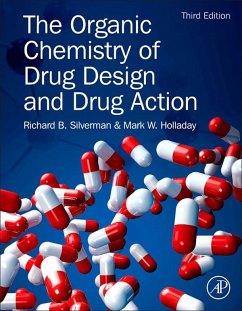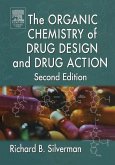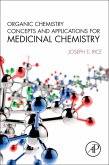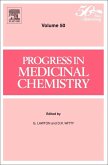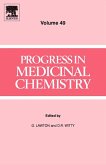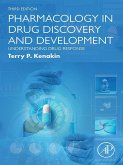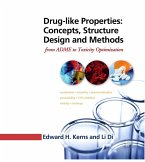The Organic Chemistry of Drug Design and Drug Action (eBook, ePUB)


Alle Infos zum eBook verschenken

The Organic Chemistry of Drug Design and Drug Action (eBook, ePUB)
- Format: ePub
- Merkliste
- Auf die Merkliste
- Bewerten Bewerten
- Teilen
- Produkt teilen
- Produkterinnerung
- Produkterinnerung

Hier können Sie sich einloggen

Bitte loggen Sie sich zunächst in Ihr Kundenkonto ein oder registrieren Sie sich bei bücher.de, um das eBook-Abo tolino select nutzen zu können.
The Organic Chemistry of Drug Design and Drug Action, Third Edition, represents a unique approach to medicinal chemistry based on physical organic chemical principles and reaction mechanisms that rationalize drug action, which allows reader to extrapolate those core principles and mechanisms to many related classes of drug molecules.
This new edition includes updates to all chapters, including new examples and references. It reflects significant changes in the process of drug design over the last decade and preserves the successful approach of the previous editions while including…mehr
- Geräte: eReader
- ohne Kopierschutz
- eBook Hilfe
![The Organic Chemistry of Drug Design and Drug Action (eBook, ePUB) The Organic Chemistry of Drug Design and Drug Action (eBook, ePUB)]() Richard B. Silverman Ph. D Organic ChemistryThe Organic Chemistry of Drug Design and Drug Action (eBook, ePUB)59,95 €
Richard B. Silverman Ph. D Organic ChemistryThe Organic Chemistry of Drug Design and Drug Action (eBook, ePUB)59,95 €![Organic Chemistry Concepts and Applications for Medicinal Chemistry (eBook, ePUB) Organic Chemistry Concepts and Applications for Medicinal Chemistry (eBook, ePUB)]() Joseph E. RiceOrganic Chemistry Concepts and Applications for Medicinal Chemistry (eBook, ePUB)34,95 €
Joseph E. RiceOrganic Chemistry Concepts and Applications for Medicinal Chemistry (eBook, ePUB)34,95 €![Progress in Medicinal Chemistry (eBook, ePUB) Progress in Medicinal Chemistry (eBook, ePUB)]() Progress in Medicinal Chemistry (eBook, ePUB)133,95 €
Progress in Medicinal Chemistry (eBook, ePUB)133,95 €![Progress in Medicinal Chemistry (eBook, ePUB) Progress in Medicinal Chemistry (eBook, ePUB)]() Progress in Medicinal Chemistry (eBook, ePUB)133,95 €
Progress in Medicinal Chemistry (eBook, ePUB)133,95 €![Biological and Pharmacological Properties of the Genus Moringa (eBook, ePUB) Biological and Pharmacological Properties of the Genus Moringa (eBook, ePUB)]() Biological and Pharmacological Properties of the Genus Moringa (eBook, ePUB)48,95 €
Biological and Pharmacological Properties of the Genus Moringa (eBook, ePUB)48,95 €![Pharmacology in Drug Discovery and Development (eBook, ePUB) Pharmacology in Drug Discovery and Development (eBook, ePUB)]() Terry P. KenakinPharmacology in Drug Discovery and Development (eBook, ePUB)64,95 €
Terry P. KenakinPharmacology in Drug Discovery and Development (eBook, ePUB)64,95 €![Drug-like Properties: Concepts, Structure Design and Methods (eBook, ePUB) Drug-like Properties: Concepts, Structure Design and Methods (eBook, ePUB)]() Li DiDrug-like Properties: Concepts, Structure Design and Methods (eBook, ePUB)63,95 €
Li DiDrug-like Properties: Concepts, Structure Design and Methods (eBook, ePUB)63,95 €-
-
-
This new edition includes updates to all chapters, including new examples and references. It reflects significant changes in the process of drug design over the last decade and preserves the successful approach of the previous editions while including significant changes in format and coverage.
This text is designed for undergraduate and graduate students in chemistry studying medicinal chemistry or pharmaceutical chemistry; research chemists and biochemists working in pharmaceutical and biotechnology industries.
- Updates to all chapters, including new examples and references
- Chapter 1 (Introduction): Completely rewritten and expanded as an overview of topics discussed in detail throughout the book
- Chapter 2 (Lead Discovery and Lead Modification): Sections on sources of compounds for screening including library collections, virtual screening, and computational methods, as well as hit-to-lead and scaffold hopping; expanded sections on sources of lead compounds, fragment-based lead discovery, and molecular graphics; and deemphasized solid-phase synthesis and combinatorial chemistry
- Chapter 3 (Receptors): Drug-receptor interactions, cation-p and halogen bonding; atropisomers; case history of the insomnia drug suvorexant
- Chapter 4 (Enzymes): Expanded sections on enzyme catalysis in drug discovery and enzyme synthesis
- Chapter 5 (Enzyme Inhibition and Inactivation): New case histories:
- for competitive inhibition, the epidermal growth factor receptor tyrosine kinase inhibitor, erlotinib and Abelson kinase inhibitor, imatinib
- for transition state analogue inhibition, the purine nucleoside phosphorylase inhibitors, forodesine and DADMe-ImmH, as well as the mechanism of the multisubstrate analog inhibitor isoniazid
- for slow, tight-binding inhibition, the dipeptidyl peptidase-4 inhibitor, saxagliptin
- Chapter 7 (Drug Resistance and Drug Synergism): This new chapter includes topics taken from two chapters in the previous edition, with many new examples
- Chapter 8 (Drug Metabolism): Discussions of toxicophores and reactive metabolites
- Chapter 9 (Prodrugs and Drug Delivery Systems): Discussion of antibody-drug conjugates
Dieser Download kann aus rechtlichen Gründen nur mit Rechnungsadresse in A, B, BG, CY, CZ, D, DK, EW, E, FIN, F, GR, HR, H, IRL, I, LT, L, LR, M, NL, PL, P, R, S, SLO, SK ausgeliefert werden.
- Produktdetails
- Verlag: Elsevier Science & Techn.
- Seitenzahl: 536
- Erscheinungstermin: 29. März 2014
- Englisch
- ISBN-13: 9780123820310
- Artikelnr.: 41044431
- Verlag: Elsevier Science & Techn.
- Seitenzahl: 536
- Erscheinungstermin: 29. März 2014
- Englisch
- ISBN-13: 9780123820310
- Artikelnr.: 41044431
- Herstellerkennzeichnung Die Herstellerinformationen sind derzeit nicht verfügbar.
Activity Relationships 2.2.4. Structure Modifications to Increase Potency, Therapeutic Index, and ADME Properties 2.2.4.1. Homologation 2.2.4.2. Chain Branching 2.2.4.3. Bioisosterism 2.2.4.4. Conformational Constraints and Ring-Chain Transformations 2.2.4.5. Peptidomimetics 2.2.5. Structure Modifications to Increase Oral Bioavailability and Membrane Permeability 2.2.5.1. Electronic Effects: The Hammett Equation 2.2.5.2. Lipophilicity Effects 2.2.5.2.1. Importance of Lipophilicity 2.2.5.2.2. Measurement of Lipophilicities 2.2.5.2.3. Computer Automation of log P Determination 2.2.5.2.4. Membrane Lipophilicity 2.2.5.3. Balancing Potency of Ionizable Compounds with Lipophilicity and Oral Bioavailability 2.2.5.4. Properties that Influence Ability to Cross the Blood
Brain Barrier 2.2.5.5. Correlation of Lipophilicity with Promiscuity and Toxicity 2.2.6. Computational Methods in Lead Modification 2.2.6.1. Overview 2.2.6.2. Quantitative Structure
Activity Relationships (QSARs) 2.2.6.2.1. Historical Overview. Steric Effects: The Taft Equation and Other Equations 2.2.6.2.2. Methods Used to Correlate Physicochemical Parameters with Biological Activity 2.2.6.2.2.1. Hansch Analysis: A Linear Multiple Regression Analysis 2.2.6.2.2.2. Manual Stepwise Methods: Topliss Operational Schemes and Others 2.2.6.2.2.3. Batch Selection Methods: Batchwise Topliss Operational Scheme, Cluster Analysis, and Others 2.2.6.2.2.4. Free and Wilson or de Novo Method 2.2.6.2.2.5. Computational Methods for ADME Descriptors 2.2.6.3. Scaffold Hopping 2.2.6.4. Molecular Graphics-Based Lead Modification 2.2.7. Epilogue 2.3. General References 2.4. Problems References 3. Receptors 3.1. Introduction 3.2. Drug
Receptor Interactions 3.2.1. General Considerations 3.2.2. Important Interactions (Forces) Involved in the Drug
Receptor Complex 3.2.2.1. Covalent Bonds 3.2.2.2. Ionic (or Electrostatic) Interactions 3.2.2.3. Ion
Dipole and Dipole
Dipole Interactions 3.2.2.4. Hydrogen Bonds 3.2.2.5. Charge
Transfer Complexes 3.2.2.6. Hydrophobic Interactions 3.2.2.7. Cation
p Interaction 3.2.2.8. Halogen Bonding 3.2.2.9. van der Waals or London Dispersion Forces 3.2.2.10. Conclusion 3.2.3. Determination of Drug
Receptor Interactions 3.2.4. Theories for Drug
Receptor Interactions 3.2.4.1. Occupancy Theory 3.2.4.2. Rate Theory 3.2.4.3. Induced-Fit Theory 3.2.4.4. Macromolecular Perturbation Theory 3.2.4.5. Activation
Aggregation Theory 3.2.4.6. The Two-State (Multistate) Model of Receptor Activation 3.2.5. Topographical and Stereochemical Considerations 3.2.5.1. Spatial Arrangement of Atoms 3.2.5.2. Drug and Receptor Chirality 3.2.5.3. Diastereomers 3.2.5.4. Conformational Isomers 3.2.5.5. Atropisomers 3.2.5.6. Ring Topology 3.2.6. Case History of the Pharmacodynamically Driven Design of a Receptor Antagonist: Cimetidine 3.2.7. Case History of the Pharmacokinetically Driven Design of Suvorexant 3.3. General References 3.4. Problems References 4. Enzymes 4.1. Enzymes as Catalysts 4.1.1. What are Enzymes? 4.1.2. How do Enzymes Work? 4.1.2.1. Specificity of Enzyme-Catalyzed Reactions 4.1.2.1.1. Binding Specificity 4.1.2.1.2. Reaction Specificity 4.1.2.2. Rate Acceleration 4.2. Mechanisms of Enzyme Catalysis 4.2.1. Approximation 4.2.2. Covalent Catalysis 4.2.3. General Acid
Base Catalysis 4.2.4. Electrostatic Catalysis 4.2.5. Desolvation 4.2.6. Strain or Distortion 4.2.7. Example of the Mechanisms of Enzyme Catalysis 4.3. Coenzyme Catalysis 4.3.1. Pyridoxal 5'-Phosphate 4.3.1.1. Racemases 4.3.1.2. Decarboxylases 4.3.1.3. Aminotransferases (Formerly Transaminases) 4.3.1.4. PLP-Dependent ß-Elimination 4.3.2. Tetrahydrofolate and Pyridine Nucleotides 4.3.3. Flavin 4.3.3.1. Two-Electron (Carbanion) Mechanism 4.3.3.2. Carbanion Followed by Two One-Electron Transfers 4.3.3.3. One-Electron Mechanism 4.3.3.4. Hydride Mechanism 4.3.4. Heme 4.3.5. Adenosine Triphosphate and Coenzyme A 4.4. Enzyme Catalysis in Drug Discovery 4.4.1. Enzymatic Synthesis of Chiral Drug Intermediates 4.4.2. Enzyme Therapy 4.5. General References 4.6. Problems References 5. Enzyme Inhibition and Inactivation 5.1. Why Inhibit an Enzyme? 5.2. Reversible Enzyme Inhibitors 5.2.1. Mechanism of Reversible Inhibition 5.2.2. Selected Examples of Competitive Reversible Inhibitor Drugs 5.2.2.1. Simple Competitive Inhibition 5.2.2.1.1. Epidermal Growth Factor Receptor Tyrosine Kinase as a Target for Cancer 5.2.2.1.2. Discovery and Optimization of EGFR Inhibitors 5.2.2.2. Stabilization of an Inactive Conformation: Imatinib, an Antileukemia Drug 5.2.2.2.1. The Target: Bcr-Abl, a Constitutively Active Kinase 5.2.2.2.2. Lead Discovery and Modification 5.2.2.2.3. Binding Mode of Imatinib to Abl Kinase 5.2.2.2.4. Inhibition of Other Kinases by Imatinib 5.2.2.3. Alternative Substrate Inhibition: Sulfonamide Antibacterial Agents (Sulfa Drugs) 5.2.2.3.1. Lead Discovery 5.2.2.3.2. Lead Modification 5.2.2.3.3. Mechanism of Action 5.2.3. Transition State Analogs and Multisubstrate Analogs 5.2.3.1. Theoretical Basis 5.2.3.2. Transition State Analogs 5.2.3.2.1. Enalaprilat 5.2.3.2.2. Pentostatin 5.2.3.2.3. Forodesine and DADMe-ImmH 5.2.3.2.4. Multisubstrate Analogs 5.2.4. Slow, T ight-Binding Inhibitors 5.2.4.1. Theoretical Basis 5.2.4.2. Captopril, Enalapril, Lisinopril, and Other Antihypertensive Drugs 5.2.4.2.1. Humoral Mechanism for Hypertension 5.2.4.2.2. Lead Discovery 5.2.4.2.3. Lead Modification and Mechanism of Action 5.2.4.2.4. Dual-Acting Drugs: Dual-Acting Enzyme Inhibitors 5.2.4.3. Lovastatin (Mevinolin) and Simvastatin, Antihypercholesterolemic Drugs 5.2.4.3.1. Cholesterol and Its Effects 5.2.4.3.2. Lead Discovery 5.2.4.3.3. Mechanism of Action 5.2.4.3.4. Lead Modification 5.2.4.4. Saxagliptin, a Dipeptidyl Peptidase-4 Inhibitor and Antidiabetes Drug 5.2.5. Case History of Rational Drug Design of an Enzyme Inhibitor: Ritonavir 5.2.5.1. Lead Discovery 5.2.5.2. Lead Modification 5.3. Irreversible Enzyme Inhibitors 5.3.1. Potential of Irreversible Inhibition 5.3.2. Affinity Labeling Agents 5.3.2.1. Mechanism of Action 5.3.2.2. Selected Affinity Labeling Agents 5.3.2.2.1. Penicillins and Cephalosporins/Cephamycins 5.3.2.2.2. Aspirin 5.3.3. Mechanism-Based Enzyme Inactivators 5.3.3.1. Theoretical Aspects 5.3.3.2. Potential Advantages in Drug Design Relative to Affinity Labeling Agents 5.3.3.3. Selected Examples of Mechanism-Based Enzyme Inactivators 5.3.3.3.1. Vigabatrin, an Anticonvulsant Drug 5.3.3.3.2. Eflornithine, an Antiprotozoal Drug and Beyond 5.3.3.3.3. Tranylcypromine, an Antidepressant Drug 5.3.3.3.4. Selegiline (l-Deprenyl) and Rasagiline: Antiparkinsonian Drugs 5.3.3.3.5. 5-Fluoro-2' -deoxyuridylate, Floxuridine, and 5-Fluorouracil: Antitumor Drugs 5.4. General References 5.5. Problems References 6. DNA-Interactive Agents 6.1. Introduction 6.1.1. Basis for DNA-Interactive Drugs 6.1.2. Toxicity of DNA-Interactive Drugs 6.1.3. Combination Chemotherapy 6.1.4. Drug Interactions 6.1.5. Drug Resistance 6.2. DNA Structure and Properties 6.2.1. Basis for the Structure of DNA 6.2.2. Base Tautomerization 6.2.3. DNA Shapes 6.2.4. DNA Conformations 6.3. Classes of Drugs that Interact with DNA 6.3.1. Reversible DNA Binders 6.3.1.1. External Electrostatic Binding 6.3.1.2. Groove Binding 6.3.1.3. Intercalation and Topoisomerase-Induced DNA Damage 6.3.1.3.1. Amsacrine, an Acridine Analog 6.3.1.3.2. Dactinomycin, the Parent Actinomycin Analog 6.3.1.3.3. Doxorubicin (Adriamycin) and Daunorubicin (Daunomycin), Anthracycline Antitumor Antibiotics 6.3.1.3.4. Bis-intercalating Agents 6.3.2. DNA Alkylators 6.3.2.1. Nitrogen Mustards 6.3.2.1.1. Lead Discovery 6.3.2.1.2. Chemistry of Alkylating Agents 6.3.2.1.3. Lead Modification 6.3.2.2. Ethylenimines 6.3.2.3. Methanesulfonates 6.3.2.4. (+)-CC-1065 and Duocarmycins 6.3.2.5. Metabolically Activated Alkylating Agents 6.3.2.5.1. Nitrosoureas 6.3.2.5.2. Triazene Antitumor Drugs 6.3.2.5.3. Mitomycin C 6.3.2.5.4. Leinamycin 6.3.3. DNA Strand Breakers 6.3.3.1. Anthracycline Antitumor Antibiotics 6.3.3.2. Bleomycin 6.3.3.3. Tirapazamine 6.3.3.4. Enediyne Antitumor Antibiotics 6.3.3.4.1. Esperamicins and Calicheamicins 6.3.3.4.2. Dynemicin A 6.3.3.4.3. Neocarzinostatin (Zinostatin) 6.3.3.5. Sequence Specificity for DNA-Strand Scission 6.4. General References 6.5. Problems References 7. Drug Resistance and Drug Synergism 7.1. Drug Resistance 7.1.1. What is Drug Resistance? 7.1.2. Mechanisms of Drug Resistance 7.1.2.1. Altered Target Enzyme or Receptor 7.1.2.2. Overproduction of the Target Enzyme or Receptor 7.1.2.3. Overproduction of the Substrate or Ligand for the Target Protein 7.1.2.4. Increased Drug-Destroying Mechanisms 7.1.2.5. Decreased Prodrug-Activating Mechanism 7.1.2.6. Activation of New Pathways Circumventing the Drug Effect 7.1.2.7. Reversal of Drug Action 7.1.2.8. Altered Drug Distribution to the Site of Action 7.2. Drug Synergism (Drug Combination) 7.2.1. What is Drug Synergism? 7.2.2. Mechanisms of Drug Synergism 7.2.2.1. Inhibition of a Drug-Destroying Enzyme 7.2.2.2. Sequential Blocking 7.2.2.3. Inhibition of Targets in Different Pathways 7.2.2.4. Efflux Pump Inhibitors 7.2.2.5. Use of Multiple Drugs for the Same Target 7.3. General References 7.4. Problems References 8. Drug Metabolism 8.1. Introduction 8.2. Synthesis of Radioactive Compounds 8.3. Analytical Methods in Drug Metabolism 8.3.1. Sample Preparation 8.3.2. Separation 8.3.3. Identification 8.3.4. Quantification 8.4. Pathways for Drug Deactivation and Elimination 8.4.1. Introduction 8.4.2. Phase I Transformations 8.4.2.1. Oxidative Reactions 8.4.2.1.1. Aromatic Hydroxylation 8.4.2.1.2. Alkene Epoxidation 8.4.2.1.3. Oxidations of Carbons Adjacent to sp2 Centers 8.4.2.1.4. Oxidation at Aliphatic and Alicyclic Carbon Atoms 8.4.2.1.5. Oxidations of Carbon
Nitrogen Systems 8.4.2.1.6. Oxidations of Carbon
Oxygen Systems 8.4.2.1.7. Oxidations of Carbon
Sulfur Systems 8.4.2.1.8. Other Oxidative Reactions 8.4.2.1.9. Alcohol and Aldehyde Oxidations 8.4.2.2. Reductive Reactions 8.4.2.2.1. Carbonyl Reduction 8.4.2.2.2. Nitro Reduction 8.4.2.2.3. Azo Reduction 8.4.2.2.4. Azido Reduction 8.4.2.2.5. Tertiary Amine Oxide Reduction 8.4.2.2.6. Reductive Dehalogenation 8.4.2.3. Carboxylation Reaction 8.4.2.4. Hydrolytic Reactions 8.4.3. Phase II Transformations: Conjugation Reaction 8.4.3.1. Introduction 8.4.3.2. Glucuronic Acid Conjugation 8.4.3.3. Sulfate Conjugation 8.4.3.4. Amino Acid Conjugation 8.4.3.5. Glutathione Conjugation 8.4.3.6. Water Conjugation 8.4.3.7. Acetyl Conjugation 8.4.3.8. Fatty Acid and Cholesterol Conjugation 8.4.3.9. Methyl Conjugation 8.4.4. Toxicophores and Reactive Metabolites (RMs) 8.4.5. Hard and Soft (Antedrugs) Drugs 8.5. General References 8.6. Problems References 9. Prodrugs and Drug Delivery Systems 9.1. Enzyme Activation of Drugs 9.1.1. Utility of Prodrugs 9.1.1.1. Aqueous Solubility 9.1.1.2. Absorption and Distribution 9.1.1.3. Site Specificity 9.1.1.4. Instability 9.1.1.5. Prolonged Release 9.1.1.6. Toxicity 9.1.1.7. Poor Patient Acceptability 9.1.1.8. Formulation Problems 9.1.2. Types of Prodrugs 9.2. Mechanisms of Drug Inactivation 9.2.1. Carrier-Linked Prodrugs 9.2.1.1. Carrier Linkages for Various Functional Groups 9.2.1.1.1. Alcohols, Carboxylic Acids, and Related 9.2.1.1.2. Amines and Amidines 9.2.1.1.3. Sulfonamides 9.2.1.1.4. Carbonyl Compounds 9.2.1.2. Examples of Carrier-Linked Bipartite Prodrugs 9.2.1.2.1. Prodrugs for Increased Water Solubility 9.2.1.2.2. Prodrugs for Improved Absorption and Distribution 9.2.1.2.3. Prodrugs for Site Specificity 9.2.1.2.4. Prodrugs for Stability 9.2.1.2.5. Prodrugs for Slow and Prolonged Release 9.2.1.2.6. Prodrugs to Minimize Toxicity 9.2.1.2.7. Prodrugs to Encourage Patient Acceptance 9.2.1.2.8. Prodrugs to Eliminate Formulation Problems 9.2.1.3. Macromolecular Drug Carrier Systems 9.2.1.3.1. General Strategy 9.2.1.3.2. Synthetic Polymers 9.2.1.3.3. Poly(a-Amino Acids) 9.2.1.3.4. Other Macromolecular Supports 9.2.1.4. Tripartite Prodrugs 9.2.1.5. Mutual Prodrugs (also called Codrugs) 9.2.2. Bioprecursor Prodrugs 9.2.2.1. Origins 9.2.2.2. Proton Activation: An Abbreviated Case History of the Discovery of Omeprazole 9.2.2.3. Hydrolytic Activation 9.2.2.4. Elimination Activation 9.2.2.5. Oxidative Activation 9.2.2.5.1. N- and O-Dealkylations 9.2.2.5.2. Oxidative Deamination 9.2.2.5.3. N-Oxidation 9.2.2.5.4. S-Oxidation 9.2.2.5.5. Aromatic Hydroxylation 9.2.2.5.6. Other Oxidations 9.2.2.6. Reductive Activation 9.2.2.6.5. Nitro Reduction 9.2.2.7. Nucleotide Activation 9.2.2.8. Phosphorylation Activation 9.2.2.9. Sulfation Activation 9.2.2.10. Decarboxylation Activation 9.3. General References 9.4. Problems References Appendix Index
Activity Relationships 2.2.4. Structure Modifications to Increase Potency, Therapeutic Index, and ADME Properties 2.2.4.1. Homologation 2.2.4.2. Chain Branching 2.2.4.3. Bioisosterism 2.2.4.4. Conformational Constraints and Ring-Chain Transformations 2.2.4.5. Peptidomimetics 2.2.5. Structure Modifications to Increase Oral Bioavailability and Membrane Permeability 2.2.5.1. Electronic Effects: The Hammett Equation 2.2.5.2. Lipophilicity Effects 2.2.5.2.1. Importance of Lipophilicity 2.2.5.2.2. Measurement of Lipophilicities 2.2.5.2.3. Computer Automation of log P Determination 2.2.5.2.4. Membrane Lipophilicity 2.2.5.3. Balancing Potency of Ionizable Compounds with Lipophilicity and Oral Bioavailability 2.2.5.4. Properties that Influence Ability to Cross the Blood
Brain Barrier 2.2.5.5. Correlation of Lipophilicity with Promiscuity and Toxicity 2.2.6. Computational Methods in Lead Modification 2.2.6.1. Overview 2.2.6.2. Quantitative Structure
Activity Relationships (QSARs) 2.2.6.2.1. Historical Overview. Steric Effects: The Taft Equation and Other Equations 2.2.6.2.2. Methods Used to Correlate Physicochemical Parameters with Biological Activity 2.2.6.2.2.1. Hansch Analysis: A Linear Multiple Regression Analysis 2.2.6.2.2.2. Manual Stepwise Methods: Topliss Operational Schemes and Others 2.2.6.2.2.3. Batch Selection Methods: Batchwise Topliss Operational Scheme, Cluster Analysis, and Others 2.2.6.2.2.4. Free and Wilson or de Novo Method 2.2.6.2.2.5. Computational Methods for ADME Descriptors 2.2.6.3. Scaffold Hopping 2.2.6.4. Molecular Graphics-Based Lead Modification 2.2.7. Epilogue 2.3. General References 2.4. Problems References 3. Receptors 3.1. Introduction 3.2. Drug
Receptor Interactions 3.2.1. General Considerations 3.2.2. Important Interactions (Forces) Involved in the Drug
Receptor Complex 3.2.2.1. Covalent Bonds 3.2.2.2. Ionic (or Electrostatic) Interactions 3.2.2.3. Ion
Dipole and Dipole
Dipole Interactions 3.2.2.4. Hydrogen Bonds 3.2.2.5. Charge
Transfer Complexes 3.2.2.6. Hydrophobic Interactions 3.2.2.7. Cation
p Interaction 3.2.2.8. Halogen Bonding 3.2.2.9. van der Waals or London Dispersion Forces 3.2.2.10. Conclusion 3.2.3. Determination of Drug
Receptor Interactions 3.2.4. Theories for Drug
Receptor Interactions 3.2.4.1. Occupancy Theory 3.2.4.2. Rate Theory 3.2.4.3. Induced-Fit Theory 3.2.4.4. Macromolecular Perturbation Theory 3.2.4.5. Activation
Aggregation Theory 3.2.4.6. The Two-State (Multistate) Model of Receptor Activation 3.2.5. Topographical and Stereochemical Considerations 3.2.5.1. Spatial Arrangement of Atoms 3.2.5.2. Drug and Receptor Chirality 3.2.5.3. Diastereomers 3.2.5.4. Conformational Isomers 3.2.5.5. Atropisomers 3.2.5.6. Ring Topology 3.2.6. Case History of the Pharmacodynamically Driven Design of a Receptor Antagonist: Cimetidine 3.2.7. Case History of the Pharmacokinetically Driven Design of Suvorexant 3.3. General References 3.4. Problems References 4. Enzymes 4.1. Enzymes as Catalysts 4.1.1. What are Enzymes? 4.1.2. How do Enzymes Work? 4.1.2.1. Specificity of Enzyme-Catalyzed Reactions 4.1.2.1.1. Binding Specificity 4.1.2.1.2. Reaction Specificity 4.1.2.2. Rate Acceleration 4.2. Mechanisms of Enzyme Catalysis 4.2.1. Approximation 4.2.2. Covalent Catalysis 4.2.3. General Acid
Base Catalysis 4.2.4. Electrostatic Catalysis 4.2.5. Desolvation 4.2.6. Strain or Distortion 4.2.7. Example of the Mechanisms of Enzyme Catalysis 4.3. Coenzyme Catalysis 4.3.1. Pyridoxal 5'-Phosphate 4.3.1.1. Racemases 4.3.1.2. Decarboxylases 4.3.1.3. Aminotransferases (Formerly Transaminases) 4.3.1.4. PLP-Dependent ß-Elimination 4.3.2. Tetrahydrofolate and Pyridine Nucleotides 4.3.3. Flavin 4.3.3.1. Two-Electron (Carbanion) Mechanism 4.3.3.2. Carbanion Followed by Two One-Electron Transfers 4.3.3.3. One-Electron Mechanism 4.3.3.4. Hydride Mechanism 4.3.4. Heme 4.3.5. Adenosine Triphosphate and Coenzyme A 4.4. Enzyme Catalysis in Drug Discovery 4.4.1. Enzymatic Synthesis of Chiral Drug Intermediates 4.4.2. Enzyme Therapy 4.5. General References 4.6. Problems References 5. Enzyme Inhibition and Inactivation 5.1. Why Inhibit an Enzyme? 5.2. Reversible Enzyme Inhibitors 5.2.1. Mechanism of Reversible Inhibition 5.2.2. Selected Examples of Competitive Reversible Inhibitor Drugs 5.2.2.1. Simple Competitive Inhibition 5.2.2.1.1. Epidermal Growth Factor Receptor Tyrosine Kinase as a Target for Cancer 5.2.2.1.2. Discovery and Optimization of EGFR Inhibitors 5.2.2.2. Stabilization of an Inactive Conformation: Imatinib, an Antileukemia Drug 5.2.2.2.1. The Target: Bcr-Abl, a Constitutively Active Kinase 5.2.2.2.2. Lead Discovery and Modification 5.2.2.2.3. Binding Mode of Imatinib to Abl Kinase 5.2.2.2.4. Inhibition of Other Kinases by Imatinib 5.2.2.3. Alternative Substrate Inhibition: Sulfonamide Antibacterial Agents (Sulfa Drugs) 5.2.2.3.1. Lead Discovery 5.2.2.3.2. Lead Modification 5.2.2.3.3. Mechanism of Action 5.2.3. Transition State Analogs and Multisubstrate Analogs 5.2.3.1. Theoretical Basis 5.2.3.2. Transition State Analogs 5.2.3.2.1. Enalaprilat 5.2.3.2.2. Pentostatin 5.2.3.2.3. Forodesine and DADMe-ImmH 5.2.3.2.4. Multisubstrate Analogs 5.2.4. Slow, T ight-Binding Inhibitors 5.2.4.1. Theoretical Basis 5.2.4.2. Captopril, Enalapril, Lisinopril, and Other Antihypertensive Drugs 5.2.4.2.1. Humoral Mechanism for Hypertension 5.2.4.2.2. Lead Discovery 5.2.4.2.3. Lead Modification and Mechanism of Action 5.2.4.2.4. Dual-Acting Drugs: Dual-Acting Enzyme Inhibitors 5.2.4.3. Lovastatin (Mevinolin) and Simvastatin, Antihypercholesterolemic Drugs 5.2.4.3.1. Cholesterol and Its Effects 5.2.4.3.2. Lead Discovery 5.2.4.3.3. Mechanism of Action 5.2.4.3.4. Lead Modification 5.2.4.4. Saxagliptin, a Dipeptidyl Peptidase-4 Inhibitor and Antidiabetes Drug 5.2.5. Case History of Rational Drug Design of an Enzyme Inhibitor: Ritonavir 5.2.5.1. Lead Discovery 5.2.5.2. Lead Modification 5.3. Irreversible Enzyme Inhibitors 5.3.1. Potential of Irreversible Inhibition 5.3.2. Affinity Labeling Agents 5.3.2.1. Mechanism of Action 5.3.2.2. Selected Affinity Labeling Agents 5.3.2.2.1. Penicillins and Cephalosporins/Cephamycins 5.3.2.2.2. Aspirin 5.3.3. Mechanism-Based Enzyme Inactivators 5.3.3.1. Theoretical Aspects 5.3.3.2. Potential Advantages in Drug Design Relative to Affinity Labeling Agents 5.3.3.3. Selected Examples of Mechanism-Based Enzyme Inactivators 5.3.3.3.1. Vigabatrin, an Anticonvulsant Drug 5.3.3.3.2. Eflornithine, an Antiprotozoal Drug and Beyond 5.3.3.3.3. Tranylcypromine, an Antidepressant Drug 5.3.3.3.4. Selegiline (l-Deprenyl) and Rasagiline: Antiparkinsonian Drugs 5.3.3.3.5. 5-Fluoro-2' -deoxyuridylate, Floxuridine, and 5-Fluorouracil: Antitumor Drugs 5.4. General References 5.5. Problems References 6. DNA-Interactive Agents 6.1. Introduction 6.1.1. Basis for DNA-Interactive Drugs 6.1.2. Toxicity of DNA-Interactive Drugs 6.1.3. Combination Chemotherapy 6.1.4. Drug Interactions 6.1.5. Drug Resistance 6.2. DNA Structure and Properties 6.2.1. Basis for the Structure of DNA 6.2.2. Base Tautomerization 6.2.3. DNA Shapes 6.2.4. DNA Conformations 6.3. Classes of Drugs that Interact with DNA 6.3.1. Reversible DNA Binders 6.3.1.1. External Electrostatic Binding 6.3.1.2. Groove Binding 6.3.1.3. Intercalation and Topoisomerase-Induced DNA Damage 6.3.1.3.1. Amsacrine, an Acridine Analog 6.3.1.3.2. Dactinomycin, the Parent Actinomycin Analog 6.3.1.3.3. Doxorubicin (Adriamycin) and Daunorubicin (Daunomycin), Anthracycline Antitumor Antibiotics 6.3.1.3.4. Bis-intercalating Agents 6.3.2. DNA Alkylators 6.3.2.1. Nitrogen Mustards 6.3.2.1.1. Lead Discovery 6.3.2.1.2. Chemistry of Alkylating Agents 6.3.2.1.3. Lead Modification 6.3.2.2. Ethylenimines 6.3.2.3. Methanesulfonates 6.3.2.4. (+)-CC-1065 and Duocarmycins 6.3.2.5. Metabolically Activated Alkylating Agents 6.3.2.5.1. Nitrosoureas 6.3.2.5.2. Triazene Antitumor Drugs 6.3.2.5.3. Mitomycin C 6.3.2.5.4. Leinamycin 6.3.3. DNA Strand Breakers 6.3.3.1. Anthracycline Antitumor Antibiotics 6.3.3.2. Bleomycin 6.3.3.3. Tirapazamine 6.3.3.4. Enediyne Antitumor Antibiotics 6.3.3.4.1. Esperamicins and Calicheamicins 6.3.3.4.2. Dynemicin A 6.3.3.4.3. Neocarzinostatin (Zinostatin) 6.3.3.5. Sequence Specificity for DNA-Strand Scission 6.4. General References 6.5. Problems References 7. Drug Resistance and Drug Synergism 7.1. Drug Resistance 7.1.1. What is Drug Resistance? 7.1.2. Mechanisms of Drug Resistance 7.1.2.1. Altered Target Enzyme or Receptor 7.1.2.2. Overproduction of the Target Enzyme or Receptor 7.1.2.3. Overproduction of the Substrate or Ligand for the Target Protein 7.1.2.4. Increased Drug-Destroying Mechanisms 7.1.2.5. Decreased Prodrug-Activating Mechanism 7.1.2.6. Activation of New Pathways Circumventing the Drug Effect 7.1.2.7. Reversal of Drug Action 7.1.2.8. Altered Drug Distribution to the Site of Action 7.2. Drug Synergism (Drug Combination) 7.2.1. What is Drug Synergism? 7.2.2. Mechanisms of Drug Synergism 7.2.2.1. Inhibition of a Drug-Destroying Enzyme 7.2.2.2. Sequential Blocking 7.2.2.3. Inhibition of Targets in Different Pathways 7.2.2.4. Efflux Pump Inhibitors 7.2.2.5. Use of Multiple Drugs for the Same Target 7.3. General References 7.4. Problems References 8. Drug Metabolism 8.1. Introduction 8.2. Synthesis of Radioactive Compounds 8.3. Analytical Methods in Drug Metabolism 8.3.1. Sample Preparation 8.3.2. Separation 8.3.3. Identification 8.3.4. Quantification 8.4. Pathways for Drug Deactivation and Elimination 8.4.1. Introduction 8.4.2. Phase I Transformations 8.4.2.1. Oxidative Reactions 8.4.2.1.1. Aromatic Hydroxylation 8.4.2.1.2. Alkene Epoxidation 8.4.2.1.3. Oxidations of Carbons Adjacent to sp2 Centers 8.4.2.1.4. Oxidation at Aliphatic and Alicyclic Carbon Atoms 8.4.2.1.5. Oxidations of Carbon
Nitrogen Systems 8.4.2.1.6. Oxidations of Carbon
Oxygen Systems 8.4.2.1.7. Oxidations of Carbon
Sulfur Systems 8.4.2.1.8. Other Oxidative Reactions 8.4.2.1.9. Alcohol and Aldehyde Oxidations 8.4.2.2. Reductive Reactions 8.4.2.2.1. Carbonyl Reduction 8.4.2.2.2. Nitro Reduction 8.4.2.2.3. Azo Reduction 8.4.2.2.4. Azido Reduction 8.4.2.2.5. Tertiary Amine Oxide Reduction 8.4.2.2.6. Reductive Dehalogenation 8.4.2.3. Carboxylation Reaction 8.4.2.4. Hydrolytic Reactions 8.4.3. Phase II Transformations: Conjugation Reaction 8.4.3.1. Introduction 8.4.3.2. Glucuronic Acid Conjugation 8.4.3.3. Sulfate Conjugation 8.4.3.4. Amino Acid Conjugation 8.4.3.5. Glutathione Conjugation 8.4.3.6. Water Conjugation 8.4.3.7. Acetyl Conjugation 8.4.3.8. Fatty Acid and Cholesterol Conjugation 8.4.3.9. Methyl Conjugation 8.4.4. Toxicophores and Reactive Metabolites (RMs) 8.4.5. Hard and Soft (Antedrugs) Drugs 8.5. General References 8.6. Problems References 9. Prodrugs and Drug Delivery Systems 9.1. Enzyme Activation of Drugs 9.1.1. Utility of Prodrugs 9.1.1.1. Aqueous Solubility 9.1.1.2. Absorption and Distribution 9.1.1.3. Site Specificity 9.1.1.4. Instability 9.1.1.5. Prolonged Release 9.1.1.6. Toxicity 9.1.1.7. Poor Patient Acceptability 9.1.1.8. Formulation Problems 9.1.2. Types of Prodrugs 9.2. Mechanisms of Drug Inactivation 9.2.1. Carrier-Linked Prodrugs 9.2.1.1. Carrier Linkages for Various Functional Groups 9.2.1.1.1. Alcohols, Carboxylic Acids, and Related 9.2.1.1.2. Amines and Amidines 9.2.1.1.3. Sulfonamides 9.2.1.1.4. Carbonyl Compounds 9.2.1.2. Examples of Carrier-Linked Bipartite Prodrugs 9.2.1.2.1. Prodrugs for Increased Water Solubility 9.2.1.2.2. Prodrugs for Improved Absorption and Distribution 9.2.1.2.3. Prodrugs for Site Specificity 9.2.1.2.4. Prodrugs for Stability 9.2.1.2.5. Prodrugs for Slow and Prolonged Release 9.2.1.2.6. Prodrugs to Minimize Toxicity 9.2.1.2.7. Prodrugs to Encourage Patient Acceptance 9.2.1.2.8. Prodrugs to Eliminate Formulation Problems 9.2.1.3. Macromolecular Drug Carrier Systems 9.2.1.3.1. General Strategy 9.2.1.3.2. Synthetic Polymers 9.2.1.3.3. Poly(a-Amino Acids) 9.2.1.3.4. Other Macromolecular Supports 9.2.1.4. Tripartite Prodrugs 9.2.1.5. Mutual Prodrugs (also called Codrugs) 9.2.2. Bioprecursor Prodrugs 9.2.2.1. Origins 9.2.2.2. Proton Activation: An Abbreviated Case History of the Discovery of Omeprazole 9.2.2.3. Hydrolytic Activation 9.2.2.4. Elimination Activation 9.2.2.5. Oxidative Activation 9.2.2.5.1. N- and O-Dealkylations 9.2.2.5.2. Oxidative Deamination 9.2.2.5.3. N-Oxidation 9.2.2.5.4. S-Oxidation 9.2.2.5.5. Aromatic Hydroxylation 9.2.2.5.6. Other Oxidations 9.2.2.6. Reductive Activation 9.2.2.6.5. Nitro Reduction 9.2.2.7. Nucleotide Activation 9.2.2.8. Phosphorylation Activation 9.2.2.9. Sulfation Activation 9.2.2.10. Decarboxylation Activation 9.3. General References 9.4. Problems References Appendix Index
